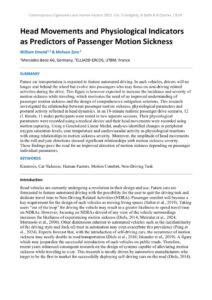| Document | Author William Emond1,2 & Mohsen Zare 2 |
| Abstract Future car transportation is expected to feature automated driving. In such vehicles, drivers will no longer seat behind the wheel but evolve into passengers who may focus on non-driving related activities during the drive. This figure is however expected to increase the incidence and severity of motion sickness while traveling, which motivates the need of an improved understanding of passenger motion sickness and the design of comprehensive mitigation solutions. This research investigated the relationship between passenger motion sickness, physiological parameters and postural activity reflected in head dynamics. In an 18-minute realistic passenger drive scenario, 12 (1 female, 11 male) participants were tested in two separate sessions. Their physiological parameters were recorded using a medical device and their head movements were recorded using motion capturing. Using a Generalized Linear Model, analyses identified changes in peripheral oxygen saturation levels, core temperature and cardiovascular activity as physiological reactions with strong relationships to motion sickness severity. Moreover, the amplitude of head movements in the roll and yaw directions showed significant relationships with motion sickness severity. These findings pave the road for an improved detection of motion sickness depending on passenger individual parameters. |

